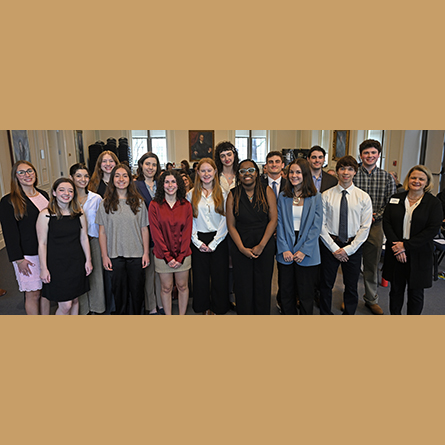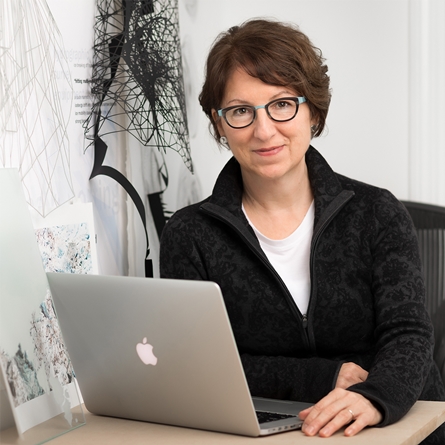
Curated by The Ammerman Center for Arts and Technology
Hosted by Hygienic Art Gallery
79 Bank Street, New London
Friday, February 26, 2016, 5 - 9 p.m.
February 26 - March 12, 2016
Ports, as physical places, demarcate points of passage such as arrival and departure, entry and exit. Virtual ports (such as network and computer ports) undergird our digital connectivity. We now exist in an era in which we attempt to balance access, information, security, privacy and freedom. Ports have gained newfound significance, no longer understood solely as traffic nodes, but as points of a larger exploration and reflection on connectivity and sharing. As such, they lead us to a revealing diversity of perspectives that range from corporeality to virtuality, and from empowerment to vulnerability.
OpenEnded Group’s Detroit Transect project was produced over five years in the city in which the dreams of the American Industrial Age rose and failed in the most spectacular fashion. Exploring the Detroit’s streetscape, schools and history using custom-made technological systems, the group evokes a lyrical, eerie sense of presence as they attempt to unravel the myth and history of this city through motion and imagery. The exhibition features three excerpts from the project in full 3D projection.
The Open All Ports group exhibition includes a roster of artists from around the world, whose work engages the command or plea suggested by the exhibition’s title in myriad ways. Through works ranging from hypothetical plant networks serving as music video selectors to lyrical sculptures based on laser scans from the Arctic Circle, from a video game taking on God to terrifyingly beautiful depictions of the horrors enacted on women in a theocratic regime, we ask: What if, once all the points of connection were made available, new linkages could indeed take place? New representations, previously unseen, were afforded the platform for visibility and voice? New and unknown interfaces, realized? All the “big data” was completely unfiltered, flowing in all directions? What if we opened all ports?
- Nadav Assor, Curator

Hygienic Art is a non-profit arts organization dedicated to creating an enriching cultural experience in the city of New London, CT.
Artists
OpenEndedGroup: Paul Kaiser and Marc Downie
Excerpts from "Detroit Transect"
3D Video
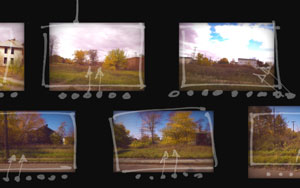
Circling — 15:13
An evocation of the circle as a one-time emblem of modernity — given striking prominence in Detroit’s first attempt to revitalize its downtown in the 1970s. The film draws principally upon footage shot from the Detroit’s PeopleMover monorail, from a helicopter survey of downtown, and from street-level explorations with hand-held and car-mounted cameras. Circling’s cutting pattern forms a kind of circular chain, the rule being that each shot must show something that can be seen in the next. Rather than continuity, however, this results in striking dislocations, ones that typify much of the Detroit experience.
Atlas: Palimpsests — 2:56
Digital imaging allows us to peer beneath pasted updates in the Sanborn Fire Insurance Atlas of Detroit, a remarkable artifact of the analog age of information. We recover glimpses of the rooming houses and mechanics’ shops long since replaced by parking lots, freeways, and ruin.
Coda: Two Schools — 3:45
An elegy to two abandoned elementary schools to be found at nearly opposite ends of the city.
Detroit Transect was created with the support of the Witt Residency Program at the Stamps School of Art & Design, University of Michigan, and The John S. and James L. Knight Foundation.
OpenEndedGroup comprises two digital artists, Marc Downie and Paul Kaiser, whose long collaboration dates back to 2001. (Shelley Eshkar was a part of the group until 2014.) Marc Downie, who comes from Aberdeen, Scotland, started playing piano and programming computers at a very early age. His Media Lab PhD thesis work has expanded into the open source Field software the group relies upon to this day.
Kaiser, who grew up in many places, has long since settled in Manhattan. His background is in experimental film and writing, though he attributes much of what he knows to the learning disabled schoolchildren whom he taught in the 1980s before returning full-time to art-making and to writing.
OpenEndedGroup’s pioneering approach to digital art frequently combines three signature elements: non-photorealistic 3D rendering; the incorporation of body movement by motion-capture and other means; and the autonomy of artworks directed or assisted by artificial intelligence.
Over the last ten years they have worked in the broadest variety of media and venues: making art for façade, gallery, dance, stage and cinema. Their works respond to an ever-expanding range of materials — drawing, film, motion capture, photography, music, and architecture. Always in collaboration and always crossing disciplinary boundaries, they enter and exit fields without permission from, and without deference to, established disciplinary structures, finding new ways to conceive the world.
In the field of dance, they have worked most closely with Merce Cunningham (Hand-drawn Spaces, 1998; BIPED, 1999; and Loops, 2001-11), but also with Bill T. Jones (Ghostcatching, 1999, 22, 2005, and After Ghostcatching, 2010), Trisha Brown (how long does the subject linger on the edge of the volume, 2005), and Wayne McGregor (Choreographic Language Agent, 2007-2012, and Stairwell, 2010).
Their public artworks include Pedestrian (multiple sites, 2002); Enlightenment and Breath (Lincoln Center, 2006 and 2007), Recovered Light (York Minster, 2007), and Crossings (Nuit Blanche/Royal Ontario Museum, 2010).
In recent years OpenEndedGroup has created new approaches to 3D projection, which has resulted in works of digital cinema such as Upending (2010), plant (2011), All sides of the road (2012), Knight’s Rest (2013), and Saccades (2014); the interactive installations Into the Forest (2011) and Drawn Together (2012); and the chamber opera Twice through the heart (with Mark Anthony Turnage and Wayne McGregor, 2011). Detroit Transect (2013-14) is a suite of 3D films that forge a new form of “optical documentary.”
Among the prizes they have won individually or collectively are a Guggenheim Fellowship, the John Cage Award from the Foundation for Contemporary Arts, a Media Arts Fellowship from the Rockefeller Foundation, and a Bessie award for the BIPED decor. In 2015, MoMA acquired eight OpenEndedGroup films for its permanent collection.
OpenEndedGroup has presented its work at Lincoln Center, the New York Film Festival, the Barbican Center, the Hayward Gallery, ICA Boston, Sadler’s Wells, the Festival d’Automne, the Sundance Film Festival, the Detroit Institute of Art, the Rome Film Festival, the Museum of the Moving Image, SITE Santa Fe, EMPAC, MASS MoCA, the MIT Media Lab, ICA London, Jacobs Pillow Dance Festival, the Centre for Contemporary Art (Glasgow), the Kiasma museum, and many other venues. Its artists’ residencies have been at the University of Michigan, EMPAC, Le Fresnoy: studio national des arts contemporains, Georgia Tech, Arizona State University, Harvard University, Columbia University, the MIT Media Lab, the Brooklyn Academy of Music/Bell Labs, and UC: Irvine. Current residencies include the Isabella Stewart Gardner Museum, Gray Center / University of Chicago, and IRCAM.
Katherine Bennett
Transmissions From the System (2016)
Reactive light and text piece, Arduinos, Wifi, breathe sensors, custom electronics, LCD, light, MP3 player, felt
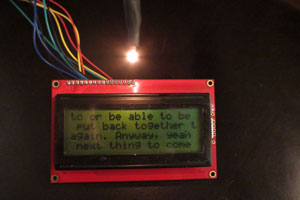
Transmissions from the System (TFS) consists of an LCD screen, a typical light bulb and a breath sensor. As a breeze moves across the sensor, the LCD screen shows Google Voice Transcriptions of my voice mail, as the light bulb wavers in its illumination. The light level is mapped to the audio envelope from the actual voice mail message. Yet, no audio is present.
Voice communication technologies bear a responsibility that is quite fragile. Voice needs to travel, in less than 150 milliseconds, across the network, arriving in the same form that it left. It cannot be transported like traditional network traffic. If any of those voice packets are lost or late, communication breaks down. Voice over Internet Protocol (VoIP) attempts to overcome these challenges. Another layer to the problem is the voice transcription software. Things get more complicate and fraught with inaccuracies when these tools combine.
TFS underscores the need to develop communication tools and highlights the absence of the real thing. Here, the light and the text are artifacts from the voice mail message. The light is a transcription of the voice created through electronics. Yet viewers are left with an absence of audio. The text transcription is an artifact of the message created from complex software and analysis. Neither can fully recreate the original transaction nor be fully accurate. Something is lost in the transmission. The viewer is left with these translation artifacts and the gapping absence of the real thing. Considering these technology’s depth and extension into our lives, and our dependency upon it, what happens when our tools are inaccurate? How does this impact us?
TFS shows the disruptions in our communications through glitches made apparent through a passing breeze. When an interface fails or breaks down, we notice it. The glitch makes what was transparent, apparent. The system code produces the text transcription, making visible the code’s inaccuracies and it’s attempt at generating human communication. The creation of the transcription breaks down and often destroys the human generated message and our language, with which it was entrusted to carry. Yet, it is the motion or the breath of a viewer that makes this process visible.
We rely heavily on voice mail and text as a substitution for in-person communication as a result of societal needs and constraints. As we develop more tools to facilitate time and productivity, they often further disrupt our communication from traditional real-time methods, affecting the content of the message itself. How does this effect our interpretation and our next action? Will these tools be honed for greater perfection? In the meantime, will we develop alternate methods and styles of communicating? TFS makes these disruptions visible and tangible.
Katherine Bennett is a media artist, programmer and interactive engineer. Her work explores the liminal spaces and temporal experiences that technology creates. Her research focuses on how communication technologies are shaping our cultural interactions. She has a history of creating environments, which make perceptible phenomena that aren't otherwise possible to experience, such as Alzheimer’s or memory flashbacks. Bennett utilizes sound and light to represent people, relationships and activities that happen in other spaces and times. Her latest interactive environments investigate the development of social networks, memory, and wireless communication traffic while experimenting with interaction thresholds. Bennett earned her MFA from The School of the Art Institute of Chicago, in Art & Technology Studies. She has won several grants. Her work has been featured in many exhibitions nationally and internationally. She runs the NYC-Creative & Experimental Software Meetup. She is a Visiting Assistant Professor, Integrated Digital Media at New York University, where she teaches physical computing, programming and interaction design.
João Costa
“and the wind was like the regret for what is no more” (2014)
wind vane, air blowers, bottles
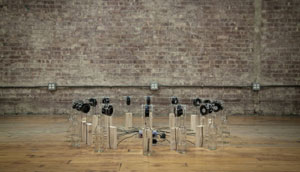
The wind outside is the source of sound; it is the whisper that will disrupt silence. This work consists of a set of sixteen bottles – with air blowers attached to each one of them – and a wind vane. The vane is fixed outside of a window and detects the direction the wind is blowing. Inside of the room, the motor starts blowing air into the bottle that corresponds to that particular direction. This event generates a smooth sound, and each direction has its own pitch. The bottles are arranged in a circle, similar to the shape of the compass rose, depicting the eight principal winds and the eight half-winds.
The work explores the interaction of two invisible factors, sound and wind. It deals with the dialectics of scattered and shapeless coefficients that cannot be seen, but have an intrinsic need of existence, of being, and nothing more. To articulate these elements is to deal with the unknown, the unpredictable. It is a failed a empt to tame them, as they have an urge for expression. Gabriele d’Annunzio has said about the meaning of the wind, in a passage that named the present work:
‘And the wind was like the regret for what is no more, like the anxiety of creatures not yet formed, laden with memories, swollen with forebodings, made up of wounded souls and useless wings.’
Artist’s Statement:
I view my creative process as a reflection of Gilles Deleuze’s rhizome: There is no hierarchy and anything can be connected. As such, my interrogation of ideas yields distinct answers to the same question, each occurring at a specific moment in time. As an artist, my task is to allow for this kind of rhizomatic chaos while still maintaining a rigor and a discipline in my practice. It is this tension between discipline and chaos that pushes me to continue creating.
My work is focused on the creation and development of systems, machines and installations that incorporate elements of nature, philosophy and sound. Observation is critical to my creative discipline, since I tend to pick materials and subjects that I can distort, alter, and push to their limits. Sound is a recurring theme in many of my pieces. Due to its elastic quality, sound can be examined, prodded, and reproduced to yield an infinite number of outcomes. In his philosophical treatise on difference and repetition, Gilles Deleuze refers to repetition as “an active force producing difference.” The reproducibility and repetitiveness of sound is what I continue to explore in my work.
João Costa is a Rio de Janeiro born, New York based, multimedia artist who is currently a Master’s Candidate at NYU’s Interactive Telecommunications Program. Costa focuses his work on the creation of systems, machines and installations that incorporate elements of nature, time and philosophy. The artist places himself in a constant experimentation of new features attempting to lead them to their limits. The investigation process is what moves his work, therefore, he dedicates most of his time searching new ways of doing the obvious, diving deeper through the beauty of chance and uncertainty.
Angela Ferraiolo
Movie of the Open Harbor (2016)
Playable Movie for Mobile Devices

Movie of the Open Harbor is a “playable”, or interactive, essay film designed for the mobile tablet. Borrowing from a new media practice of critical design and from Brecht's tradition of engaged theater, The Movie of the Open Harbor retells the myth of Kafka's emigrant Gracchus, a hunter, who after a fall finds himself at sea, forever wandering. Like thousands of present day migrants, Gracchus is never at rest but constantly in search of a home. Using a speculative camera and an associative database of images, The Movie of the Open Harbor attempts to create a playable expression of Gracchus's status as entity rather than person, and to communicate present day migration as an endless pattern or cycle, one the viewer can experience as a playable but unalterable pattern of events.
Designed for android tablets, Movie of the Open Harbor takes its form from the experimental essay form of personal narrative, using juxtaposition and association to tell its story from a database of images. Connections between scenes and events are driven by the viewer and determined algorithmically. An important aspect of this project is that narrative unfolds according to a system of rules it is not a game but a form of playable media without an outcome. Instead each of the story segments is experienced as system, or as an emotional and intellectual pattern viewers can play with, act on, interpret, and re-interpret through a responsive interface.
As viewers go through the Gracchus story and system of relationships, they move back and forth setting one pattern in a system against another. That interplay, the relationships between one set of conditions and another becomes dynamic, fluid, open. No events are primary or conclusive. It's the pattern not the specifics that gain primacy.
Movie of the Open Harbor is part of a larger group of interactive projects titled Movies for Hard Times, a series of twenty-four “playable”, or interactive, essay films designed for mobile tablets. The series is divided into thirty-six half hour segments, each a small hybrid of thoughts, image, sound, and text. Rather than following any single stable narrative form, these movies imagine “story as system”, as narrative operating like a simulation across states or modes, a game that proceeds without a goal and expresses itself cinematically.
Angela Ferraiolo is a writer and filmmaker working with noise, randomness, and generative processes. Her work has been screened nationally and internationally, including SIGGRAPH, ISEA, Courtisane, the Australian Experimental Film Festival (Melbourne), and the International Conference of Generative Art (Rome). New projects include further experiments in generative and playable video and narrative. She teaches in the Visual Arts program at Sarah Lawrence College.
Lindsey French
Panicum verbatim (Packet Switchgrass)
music videos by plants
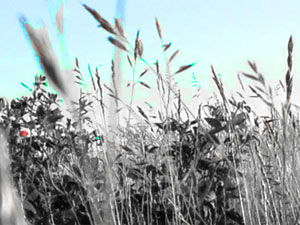
Packet Switchgrass (Panicum verbatim) is a variety of switchgrass that holds records of the use of human communication systems by vegetal life in the late 1960s. An adaptation from the ubiquitous Switchgrass (Panicum virgatum), this new species appeared in late 1950s, slightly predating the invention of packet switching and now believed to be an responsible for the creation of the internet as an extension of biological communication systems. Subtly asserting vegetational politics from the sub cultures of American soil, by the 1960s, evidence of botanical power began appearing in opposition to American military developments. Packet Switchgrass forefronted grassroots revolutions. Flowers appeared as protest tools. Human subcultures were swayed by flower power. Bernie Boston’s iconic image was a human drama and a floral performance. In war protest videos we see water sprayed across protestors, people positioned as blades of grass against violent tools. The revolution was not televised per se but we became mediated by, and media for, botanical revolution.
Michael Marder wrote that resistance to instrumentalization is a sure sign of love. Bernie Boston’s iconic image was instrumental to quiet resistance. The appearance of grasses in contemporary music shows human performers as instruments. Cybernetics boasts a natural connection between ecological systems and computer supported communication systems. This assertion is not wrong in itself, but rather in its positioning of who belongs to who. Can you dig it?
Presented here are cultural artifacts found in the archives of several key samples of Packet Switchgrass. Stored cellular memories contained as packets of heat and light assembled the stories of 1960s america. Music videos, phytocentric media, and the ubiquitous, under spoken, weak grasses that nonetheless continue a revolution.
Lindsey French is an artist and educator whose work engages in gestures of communication with landscapes and the nonhuman. Embracing a number of mediation strategies, her practice is an open series of gestures, communications, processes and research aimed toward moments of destabilizing a human-centric experience. She has shared her work in places such as the Museum of Contemporary Art in Chicago, the Chicago Cultural Center, the Chicago Perch, Sector 2337, Flying Object in Hadley, MA and in conjunction with the International Symposium of Electronics Arts in both Albuquerque and Vancouver. Her work has been featured in an essay in Leonardo and discussed on podcasts for Creative Disturbance. French currently teaches courses that explore new media practices and site specific research at the School of the Art Institute of Chicago in the Art and Technology Studies, Sculpture, and Contemporary Practices.
Brittany Ransom
Roughly 9 Translations #1, 2014, laser cut acrylic and birch: 2.5 x 1.4 x 1'
Roughly 9 Translations #4, 2015, laser cut acrylic and birch: 1 x 1 x 1'
Roughly 9 Translations #2, 2014, laser cut acrylic and birch: 2 x 1.5 x 1'
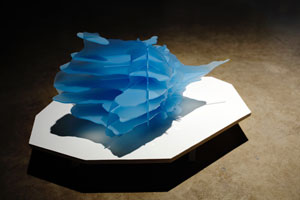
The Translation Series utilizes 3D scans that were made via cell phone photographs of glacial sea ice in the Arctic Circle (Svalbard). The glacial ice was photographed to produce a full 3D scan using open source software and was then mathematically translated into two dimensional slices to reference its rapidly changing material state / melt from ice to water under the heat of the summer solstice sun. The project overall references issues of global warming, translation of material states from solid, liquid, to image, point cloud, two dimensional slices, to plastic slices that finally make up a ghosted form that references its initial state when found in the arctic sea. These 3D prints address a the issue of the depletion of the polar ice cap and the fact that in the future, we may only be able to experience these types of natural phenomena through replication processes. Conversely, their material make up is a contributor to the depletion of this landscape.
Brittany Ransom is an artist and professor currently living in Long Beach, California and teaching at California State University Long Beach. Ransom is the recipient of numerous awards and grants including the highly competitive Workshop Residence (San Francisco 2016), Arctic Circle Research Residency (2014), University Research Council and Instructional Technology Grant Awards (2013-2014), and the prestigious College Art Association Professional Development Fellowship (2011). Her most recent work has been exhibited in Long Island City, Los Angeles, Chicago, and Dallas. Her work has been discussed in Hyperallergic, Wired UK, NBC, and Huffington Post.
Owen Roberts
God is a Ghost (2016)
3D Video game
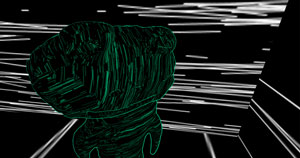
“God is a ghost” is a 3D videogame that explores the nature of faith, symbology and memory through a procedurally generated world. In the game, the player is introduced into a world filled with unknown and ambiguous symbols. The goal of the game is to translate the symbols with the help of characters populating the new world, characters who provide different information based on different ideologies. When the player “dies” or is discovered by the ghost lurking through the game, they will return to a new world where the buildings, symbols and ideologies have been algorithmically reassembled, and their search will begin anew.
Owen Roberts is an artist, writer and educator currently based in Brooklyn, New York and Shanghai, China. His work explores combining traditional drawing, writing and animation methods with new media platforms such as mobile phone applications, websites and video games. He uses new technologies for unintended purposes, like telling stories through corrupted images on a discarded flip phone, building video games no objectives or using software to write poetry. He is interested in works that appear crude and ridiculous at first but slowly reveal new meanings through exploration and interaction. He is currently teaching at at NYU Shanghai and the Borough of Manhattan Community College. His work can be viewed on his website o wenroberts.github.io.
Sheida Soleimani
Reyhaneh (2015), Archival pigment print
Vitriolic Acid (2015), Archival pigment print
Filleting (2015), Archival pigment print
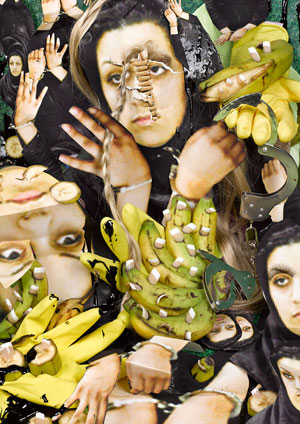
Through the examination of advances in societal communication throughout the past century, my works address the human as a collage and cyborg. By viewing the psychological body as appropriated cultural transmissions, we can see that humans choose how they compose themselves and their surroundings. The intersection of classical art practice in juxtaposition to New Media practices provides fertile grounds for pointing to these cultural transmissions, and how specific societal groups throughout history have adapted them. By studying these landmarks and changes, one can point at indicators of what exactly it means to be a human existing in this contemporary landscape.
Within my photographic scenarios, cultural symbols and signifiers are appropriated to create narratives in regards to my position as an Iranian-American viewing the Middle East from an outside lens. By focusing on media trends and the dissemination of societal occurrences through the news, I chose to source imagery from popular media, as well as social media leaks, and adapt them to exist within alternate scenarios. As a practice that serves as a bridge between installation, sculpture, and photographs, my work addresses past historical issues and their connections within a contemporary frame. Each of the photographs addresses a specific time in Middle Eastern history, while alluding to how both the East and West have responded to societal occurrences.
Sheida Soleimani is an Iranian-American artist, currently residing in Providence, Rhode Island. She is the 2015-16 Post Graduate Fellow, and Assistant Professor of Digital + Media at the Rhode Island School of Design. The daughter of two parents that are political refugees, Soleimani references situations in relevance to her own and her parent’s past, while inserting her own critical perspectives on historical and contemporary socio-political occurrences in the Middle East.
Kelly Thompson
Global Shipping, Shifted Data 1, Locator Data (2015), Weaving
Shifted Data I (2015), Hand woven, digital jacquard, cotton, linen
Global Shipping (2015), Hand woven, digital jacquard, cotton, linen
Locator Data(2015), Hand woven, digital jacquard, cotton, linen

This series of work is part a larger research project which questions data and information systems through digital weaving and intersections with my recent experiences of travelling aboard a container ship to New Zealand. Material Codes: Ephemeral Traces is a project that utilizes elements of the digital overlooked, faults, unseen or undecipherable coded language, transforming these to a very different scale and physical transformation of the virtual. It draws on old technology of threads and hand weaving and uses very contemporary design software and machines in the production of cloth which otherwise could not be woven.
The imagery in Shifted Data consist of layers of found and manipulated data files, error messages, symbols and codes of digital tracking, maps of global undersea internet cables routes, and graphs of climate data all connected through the subtle imagery of water. Extracted from a work that was “correctly woven” the same technical weave files are manipulated very slightly prior to weaving, with unexpected shifts of colour and structures in material form. This experimentation visually demonstrates the affect of slight shifts in digital data and hence the potential unreliability of information systems. Global Shipping and Locator Data respond to the ubiquitous, yet overlooked impact of container shipping and translating my observations of that world.
Kelly Thompson is an artist and Associate Professor in the Department of Studio Art, Concordia University, focusing on the Fibres and Material Practices programs (BFA & MFA). Her artistic work often utilizes mapping concepts, or represents open waters and the borders between land, sea or river, as markers of transitory moments of time, place, body and memory. Recent research-creation projects address everyday ephemeral traces, language, translation and the manipulation of data in punch card and digital jacquard weaving.
